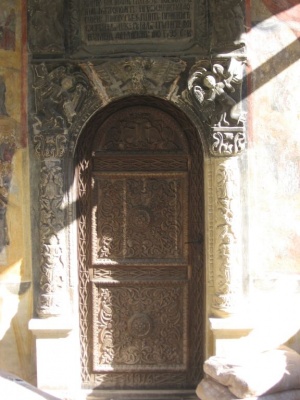Sinaia Monastery
The Sinaia Monastery, founded by Prince Mihai Cantacuzino in 1695 and named after the great Sinai Monastery at the base of Mount Sinai, is located in Romania. It is now inhabited by 20 Orthodox Christian monks.
Contents
Overview
The monastery consists of two courtyards surrounded by low buildings. In the center of each courtyard there is a small church built in the Byzantine style. One of them - "Biserica Veche" (The Old Church) - dates from 1695, while the more recent "Biserica Mare" (The Great Church) was built in 1846.
The monks possess a library that constitutes a repository for valuable jewels belonging to the Cantacuzino family, as well as the earliest Romanian translation of the Bible, dated 1668.
History
Until 1850, Sinaia consisted of little more than the monastery and a group of huts. In 1864, however, the monastic estate was assigned to the Board of Civil Hospitals (Eforia Spitalelor Civile), which opened a hospital and several baths and helped develop mineral springs in Sinaia.
In 1948 the Monastery was placed under the patronage of the Archdiocese of Bucharest by the Board of Civil Hospitals. The Romanian Patriarch Justinian then restored the buildings between the years 1951 and 1957 with the money from the Archdiocese of Bucharest. At this point they outfitted the whole monastery with running water, electricity and natural gas.
The Old Church
The Old Church was built in 1695. As of 2006 it is currently closed for renovations until it is restored to its former beauty.
The Great Church
The Great Church was first built during 1842-1846 as a smaller building. The construction occurred under the leadership of the fathers superior (Egumeni) Ioasaf and Paisie, financed by money from the monastery.
The Board of Civil Hospitals rebuilt parts of the church from 1897 to 1903. This change gave the Great Church the appearance it has today.
The current appearance
The monastery's current appearance was created by George Mandrea, an architect who combined the Moldavian style's thick walls with the Brâncovenesc style from Valachia. A green enamel belt encircles the building in three uninterrupted lines. It is said this is the symbol of the unity of Holy Trinity in one God and the unity of the three Romanian Kingdoms in one country.
The paintings
The paintings are painted on gold mosaic - typical for the neo-Byzantine style. These paintings were done by the Danish artist Aage Exner. The main pictures shows five people:
- Iosif Gheorghian mitropolit primat - igumen who opened the new building in 1903
- King Carol I (1866—1914) - dressed as an officer, with his right hand upon a rock pillar missing a piece as a symbol of the missing Romanian territories at that time: Bucovina, Basarabia and Transylvania.
- Queen Elisabeta - known in the literary world as Carmen Silva
- Princess Maria - the Queen's only child, who died at an early age
- Mihail Cantacuzino - builder of the Old Church
The furniture
The furniture is made from wood (paltin and oak) by Constantin Babic and his students at the Ṣcoala de Arte si Meserii in Bucharest. The thrones are gold-plated. The king's throne has the royal emblem and the writing Nihil sine Deo (Nothing without God). The queen's throne has the letters E.D. embossed.
The two Russian icons of Saint Serghei and Saint Nicholas were a gift from Tsar Nicholas II of Russia and were given in 1903 to the Igumen Nifon Arhimandritul for the baptism of Prince Nicholas (Nicolae), son of King Ferdinand (1914-1927).
Thanks to Carol I, the Great Church of the monastery became the first church to use the electric lights in Romania.
The Bell Tower
Under the leadership of Igumen Nifon Popescu (1888-1909) the Bell Tower was added. It was finished in 1892. The bell weights 1700 kg and was brought from the Colţea Tower in Bucharest.
The Museum
To celebrate the 200th anniversary of the Old Church in 1895, the monastery opened a museum. This was the first exhibition of church objects in Romania.
External Links
Prince Mihai Cantacuzino founded the monastery in thanksgiving for having escaped Ottoman brigands upon his return from a pilgrimage to St. Catherine's. It was named Sinaia in recognition of St. Catherine's.










